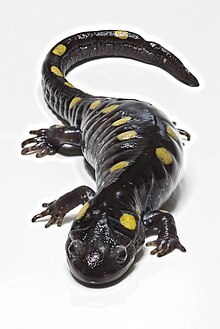At first glance salamanders appear to be a type of lizard. However, this is not true. Salamanders are their own distinct group of animals belonging to the order Caudata. Even though they do superficially resemble lizards, there are several differences that separate the two. One visual cue is that lizards usually have external ear-openings and clawed toes. Salamanders lack such features.
Salamanders are also amphibians, while lizards are reptiles. The main differences between reptiles and amphibians are that reptiles are covered in dry scales or scutes, while amphibians have moist skins. Amphibians also produce eggs that are dependent for the most part on water and moisture, while reptiles have shelled-eggs that are terrestrially adapted. Most amphibians undergo a metamorphosis from juvenile water-breathing forms to adult air-breathing forms, reptiles do not.
Salamanders first appeared on Earth some 160 million years ago. Today, there are over 600 different species of salamanders found across North and South America, and in the temperate parts of Northern Africa, Asia and Europe. Salamanders are absent from the southern regions of these continents. There are no salamanders in Australia or Antarctica. Salamanders reach their greatest diversity in the Appalachian Mountains region.
Comparison chart
Key Differences
- Class: Lizards are reptiles, while salamanders are amphibians.
- Skin: Lizards have dry, scaly skin. Salamanders have moist, smooth skin.
- Egg Laying: Lizard eggs are generally hard-shelled and laid on land, whereas salamander eggs are jelly-like and often laid in water.
- Metamorphosis: Salamanders usually undergo metamorphosis from larval to adult stages, while lizards do not.
Similarities
- Cold-blooded: Both are ectothermic, relying on external sources of heat to regulate their body temperature.
- Tail Regeneration: Many species in both groups can regenerate their tails.
- Habitat Diversity: Both lizards and salamanders can be found in a variety of habitats, although lizards are more commonly terrestrial and salamanders are often found in aquatic or damp environments.


Comments: Lizard vs Salamander